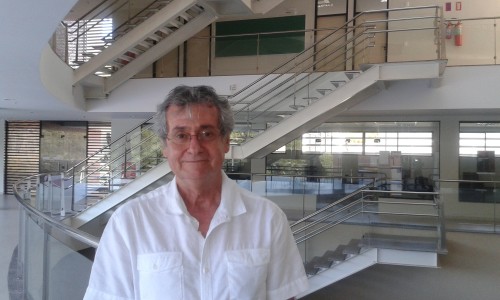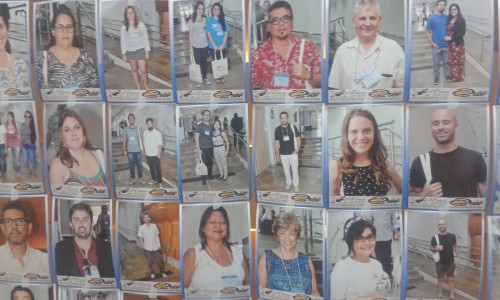Tag archives: Brazil
Conference thoughts
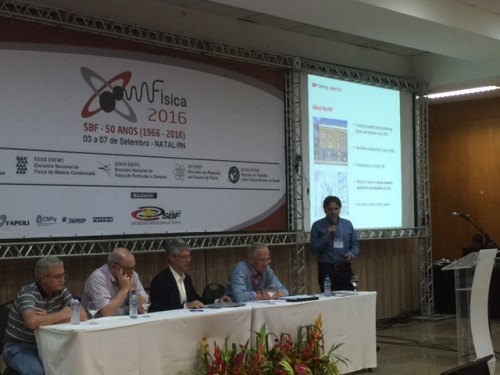
All-male line-up: Matin Durrani speaking at a round-table on the future of physics at the 50th-anniversary meeting of the Brazil Physics Society.
By Matin Durrani in Natal, Brazil
I rounded off my final full day at the 50th-anniversary meeting of the Brazil Physics Society (SBF) by taking part in a round-table on the development of physics over the next two decades organized by former SBF president Ricardo Galvão,
Alongside me (right to left in the photo above) were Christophe Rossel from IBM’s Zurich lab, who’s current president of the European Physical Society, Roger Falcone from the University of California, Berkeley who’s vice-president of the American Physical Society and will take over as head honcho in 2018, as well as Carlos Pinto de Melo from the Universidade Federal de Pernambuco, who was SBF president from 2009 to 2011. A late entry to the panel was Valentin Areviev from the Joint Institute for Nuclear Research in Dubna, Russia.
View all posts by this author | View this author's profile
A paradise for physics in Brazil
By Matin Durrani in Natal, Brazil
I took a break yesterday afternoon from the 50th anniversary meeting of the Brazil Physics Society here in Natal in the north-east of the country to visit the International Institute of Physics (IIP). Located on the campus of the Universidad Federal do Rio Grande do Norte, the IIP was founded in 2010 to carry out cutting-edge research in theoretical physics and help push forward Brazilian science on the international stage. If you’re a theorist, it’s hard to imagine a more pleasant environment for doing physics.
Previously housed in a small, cramped building (albeit with a swimming pool), the IIP moved into a shiny, new three-storey building in March this year. One striking architectural feature is the institute’s central atrium, which is fully open to the outside world. Natal has such a great climate – it’s 25–30 °C all year round and almost always sunny – that there’s no need for stuffy walls and doors. The design also lets the regular, strong breezes that blow into Natal from the Atlantic to add a delightful, cooling touch.
Antimatter comes to Brazil
By Matin Durrani in Natal, Brazil
There can’t be many physics experiments to have been visited by members of not one, but two different rock bands. But then there’s something fundamentally captivating about the work of the ALPHA collaboration at the CERN particle-physics lab near Geneva, which is studying the properties of antimatter.
As Jeffrey Hangst from Aarhus University in Denmark revealed in his plenary talk at the 50th anniversary meeting of the Brazilian Physics Society (SBF) yesterday, the ALPHA collaboration has not only played host to a visit from legendary 1970s rockers David Crosby and Graham Nash, but in July also welcomed members of British alternative “space rock” outfit Muse while they were on a visit to CERN.
View all posts by this author | View this author's profile
Sun, sea, sand – and science

Paradise for physicists – the scene just metres from the venue for the 50th anniversary meeting of the Brazilian Physics Society in Natal.
By Matin Durrani in Natal, Brazil
From London via Lisbon, I arrived yesterday evening in Natal – a city of 800,000 people on the north-eastern tip of Brazil – for the 50th anniversary meeting of the Brazilian Physics Society (SBF).
I was invited by Ricardo Galvão, previous SBF president and chair of the organizing committee, to take part in a session later in the five-day meeting about the development of physics over the next two decades.
As editor of Physics World, which is published by the Institute of Physics (IOP), I’ll be joined by representatives from other physical societies around the world.
View all posts by this author | View this author's profile
Physics road trip through the north-east of Brazil

Susan Curtis (left), Sarah Andrieu (centre) and Alvaro Ferraz admire the new IIP building in Natal.
By Susan Curtis
This week, several of us from IOP Publishing have been visiting the north-east of Brazil. Our prime focus has been the annual meeting of the Brazilian Materials Research Society in João Pessoa, where we launched a new Science Impact report highlighting materials research in Brazil. But during the week I travelled to Natal with my colleague Sarah Andrieu to visit Alvaro Ferraz, director of the International Institute of Physics (IIP).
View all posts by this author | View this author's profile
Setting the standard for Brazilian materials science

Long and low – Inmetro, Brazil’s standards lab.
By Michael Banks in Rio de Janeiro, Brazil
As part of my road-trip round Brazil, I visited Inmetro – the Brazilian standards lab. Located around 50 km north of Rio de Janeiro, Inmetro certainly has the feeling of being well away from the hustle and bustle of one of Brazil’s major cities.
The first thing that you notice when you enter Inmetro’s vast campus is that the buildings have a unique architecture (see above). The bunker-like structures are built in such a way that they are protected from the Sun, which can deliver 40 °C temperatures in summer. (Thankfully, I am here in autumn, but the temperature is still a warm 30 °C.)
Inmetro’s campus was built about 40 years ago with the help of the PTB – the German standards lab. The buildings were also specially designed so that the labs are vibrationally separate from the offices. So, any wild jumping around at your desk won’t affect the sensitive measurements in the lab.
View all posts by this author | View this author's profile
Boosting innovation in Brazil
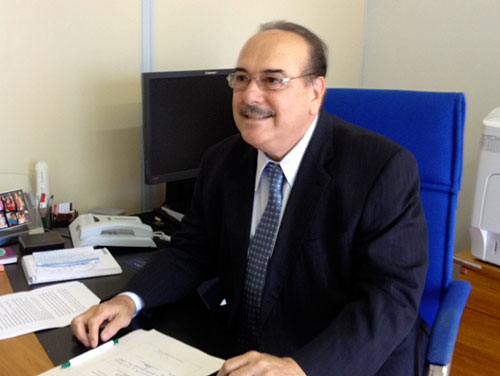
FAPEMIG boss Evaldo Ferreira Vilela.
By Michael Banks in Belo Horizonte, Brazil
I’m writing this while on a week-long road trip across Brazil to gather information for a new report that IOP Publishing, which publishes Physics World, is producing for the Brazilian Materials Research Society.
While on my trip, I have visited a number of institutes that focus on materials research. But I also had the chance to talk a bit of policy when visiting FAPEMIG – the main state funder for research in Minas Gerais, which is the second most populous state in Brazil.
In Belo Horizonte, which is the capital of Minas Gerais, I met Evaldo Ferreira Vilela, who is director of science, technology and innovation at FAPEMIG.
View all posts by this author | View this author's profile
Physics World Special Report: Brazil
By Matin Durrani
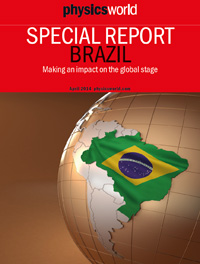
With this year’s FIFA World Cup drawing ever closer, Physics World turns its attention to Brazil – the nation hosting the planet’s biggest sporting event.
We’re not, of course, looking at the country’s footballing prowess or examining the controversial – and staggering – sums being spent on staging the World Cup.
Instead, the latest Physics World Special Report examines the challenges and opportunities for physicists in Brazil – the fifth biggest nation by size and the world’s seventh-largest economy.
Physics in the country is thriving, with the Brazilian government having more than quadrupled the amount of money invested in research and development since the turn of the century.
View all posts by this author | View this author's profile
Getting a measure of Brazilian research

A llama at São Carlos zoo yesterday.
By Matin Durrani
If you’ve been keeping an eye on this blog, you’ll remember that I spent a week in Brazil last November gathering material for an upcoming Physics World Special Report, which will examine the challenges and opportunities facing physicists in the world’s fifth largest country. I travelled to São Paulo, São José dos Campos and Rio de Janeiro, visiting everywhere from the first overseas offshoot of the International Centre for Theoretical Physics to the Brazilian National Observatory, where Brazilian research pretty much began.
I’ve just been putting the finishing touches to that report, which includes news, features and an exclusive interview with the Brazilian science minister Marco Antonio Raupp, who is a physicist by training. Brazil’s investment in science has more than quadrupled over the last decade and in the interview Raupp outlines his priorities for the Brazilian research community. Stay tuned for the Physics World Special Report, which we’ll make available via this website from next month. (One rather flippant question we asked Raupp is who he thinks will win this year’s FIFA World Cup taking place across Brazil this summer – we didn’t have room to fit his answer into the report, but I can exclusively reveal on this blog that the Brazilian science minister has got his money on the home nation. Well, he would say that, wouldn’t he?)
View all posts by this author | View this author's profile
Postcard from Campinas – the site of Brazil’s future synchrotron
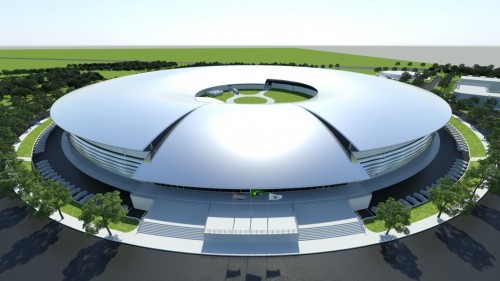
Artist’s impression of Brazil’s Sirius synchrotron source. (Courtesy: LNLS)
By Susan Curtis in Campinas, Brazil
For the first time this week I woke to a brilliant blue sky, and below my hotel room I could see young Brazilians enjoying a quick game of football in the relative cool of the morning. Away from the traffic jams and unseasonably wet weather of the past few days, this seemed much more like the image of Brazil that’s projected to the outside world.
Today I was in Campinas, the third largest city in the state of São Paulo, some 100 km north-east of São Paulo itself. On the outskirts of the city is the National Center for Energy and Materials (CNPEM), home to Brazil’s synchrotron source as well as three national laboratories for nanotechnology, biosciences and ethanol production – which is a big deal for Brazil, since it offers a way to produce fuel from its abundant sugar cane.
View all posts by this author | View this author's profile
